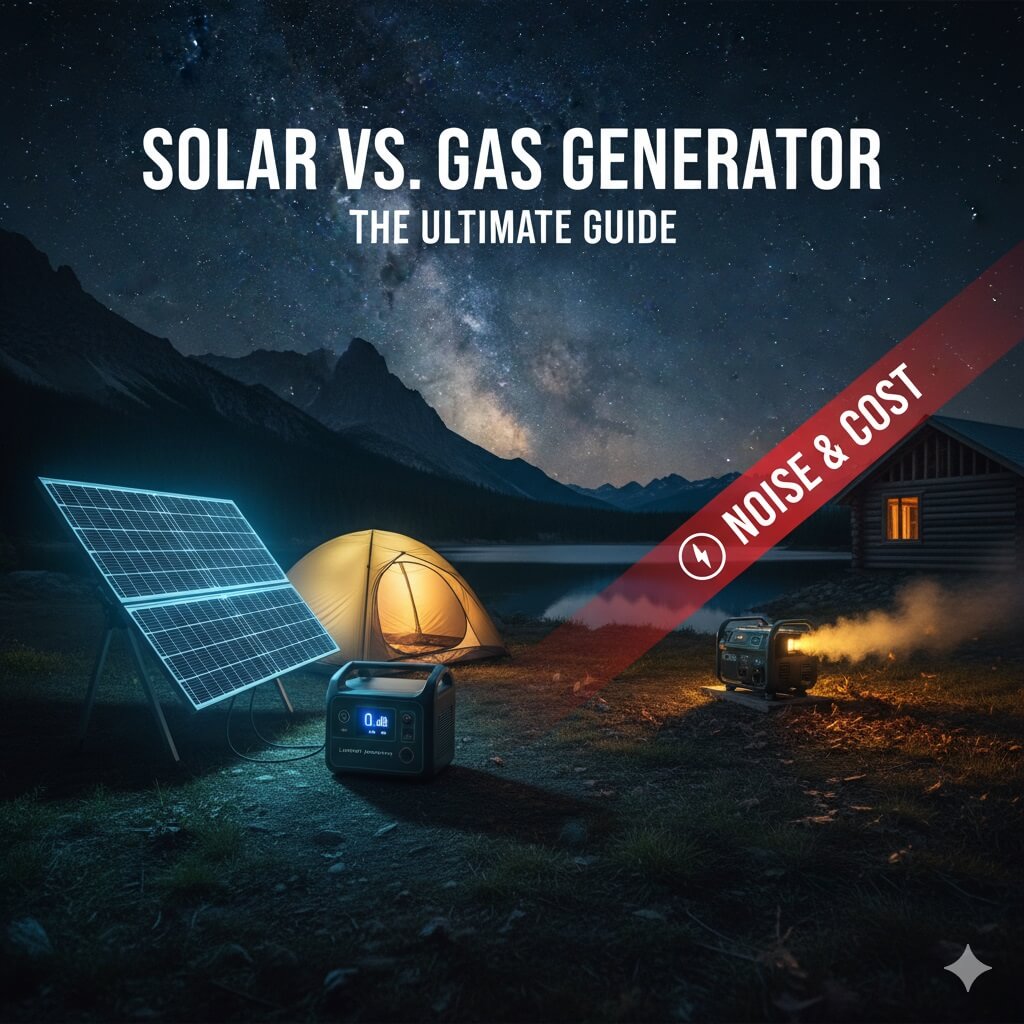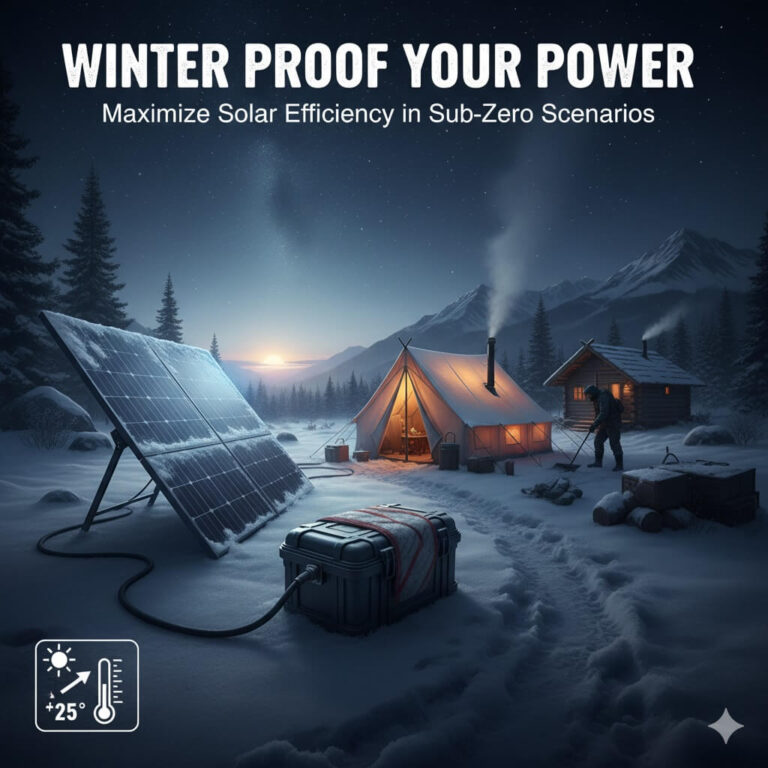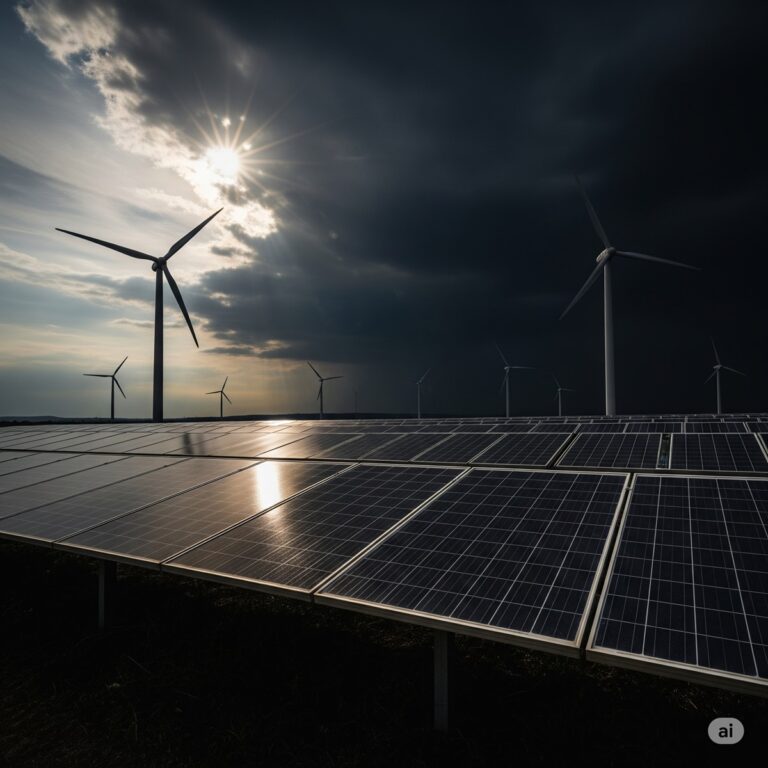Ultimate Guide: Solar vs. Gas Generator Camping: Why Silent Power is Your Tactical Edge

The pursuit of self-sufficiency—whether building a secluded cabin, mastering bushcraft, or ensuring survival preparedness—hinges on reliable power. For decades, the ubiquitous roar of a gas generator was the default solution for off-grid power. But that noise introduces noise, constant maintenance, and fuel dependence—the very opposite of preparedness and peace. The choice between a gas generator and a solar power system is no longer about raw watts; it’s about resilience, stealth, and long-term autonomy. This guide will prove why silent, sustainable solar power is the superior, tactical choice for every remote application, while also showing you how to optimize your solar setup to charge faster in the wild than you ever thought possible.
- SECTION I: THE OFF-GRID POWER FOUNDATIONS
- SECTION II: COMPONENT SELECTION & DEEP DIVE
- SECTION III: ADVANCED DESIGN & APPLICATION
- SECTION IV: LONGEVITY, SAFETY & RESILIENCE
- Conclusion: Achieving True Self-Sufficiency
- Frequently Asked Questions (FAQs)
- 1. Can I safely use a Solar Generator (Portable Power Station) inside my cabin or tent?
- 2. How much longer does a Solar Generator system last compared to a Gas Generator?
- 3. Is solar power reliable enough for a remote, off-grid cabin in cloudy or winter weather?
- 4. How quickly will a small shadow really affect my portable solar panel’s charging speed in the wild?
- 5. Are Solar Generators truly a cheaper option than Gas Generators for the long run?
SECTION I: THE OFF-GRID POWER FOUNDATIONS
Why Solar is the Cornerstone of Self-Sufficiency (And Gas is a Liability)
For the survivalist or the builder far from the nearest fuel stop, the true cost of a gas generator extends far beyond the price tag. Its liabilities directly undermine the goals of self-sufficiency:
- Noise and Stealth: In a survival scenario or on a peaceful camping trip, the 60–75 dB roar of a small gas generator is a beacon. Solar operates at 0 dB, offering a crucial tactical advantage and preserving the solitude of your remote location (Bushcraft/Survival focus).
- Fuel Logistics and Dependence: Every watt produced by a gas generator requires a gallon of fuel. Hauling and storing flammable, decaying fuel introduces complexity, danger, and a fundamental dependency on outside supply—the antithesis of self-reliance (Cabin/Survival focus).
- Maintenance Burden: Gas engines demand oil changes, spark plugs, carb cleaning, and fuel stabilization. Solar power systems, by contrast, are nearly maintenance-free, offering long-term reliability essential for remote sites (Cabin/Building focus).
Essential Power Literacy: Key Terms for the Off-Grid Power User
To effectively compare these two systems, the self-sufficient enthusiast must understand the metrics that matter most in the wild:
- Cycle Life (Solar Battery): The number of times a battery can be fully charged and discharged. This directly dictates longevity. Modern LiFePO4 batteries offer 2,000–5,000 cycles, while typical generators are lucky to last 500–1,000 hours before needing major overhauls.
- Run-Time/Fuel Consumption (Gas Generator): Measured in hours per gallon at a specific load. This metric is the gas generator’s core liability, showing how quickly your limited fuel reserve depletes.
- Discharge Rate (Solar): How quickly power can be safely drawn from the battery. High-quality portable power stations can handle large surges for power tools, matching a generator’s capability without the noise.
SECTION II: COMPONENT SELECTION & DEEP DIVE
Foundational Gear: Analyzing the Two Power Systems
The fundamental difference lies in their operational complexity and component lifespan:
- Gas System: The central component is the engine. It must be kept meticulously maintained, and its output (measured in surge/running watts) is dependent on fuel quality and altitude. Its lifespan is measured in a few hundred hours.
- Solar System (Portable Power Station): The system relies on three durable parts:
- Battery Chemistry: LiFePO4 is becoming the standard for survival and cabin use due to its superior safety, light weight, and phenomenal cycle life (5–10 times longer than standard lithium-ion).
- Inverter Capacity: Determines what you can run. A Pure Sine Wave Inverter is essential for sensitive electronics and power tools—a feature often found only on premium generators.
- Panel Efficiency: Portable panels (Mono vs. Poly) dictate charging speed.
The $500–$2500 Off-Grid Generator Cost Breakdown (TCO Analysis)
The initial purchase price of a solar generator is often higher than gas, but factoring in Total Cost of Ownership (TCO) over five years reveals solar’s financial superiority.
| Scenario | Gas Generator TCO (5 Years) | Solar Generator TCO (5 Years) | Financial Conclusion |
|---|---|---|---|
| Tier 1 (Budget/Camping): Powering lights, phones, small cooler. | $850–$1,200. ($400 unit + $450–$800 in fuel/oil/maint.) | $550–$750. ($500-650 unit + minimal maintenance). | Solar pays for itself within 2 years due to fuel savings. |
| Tier 2 (Mid-Range/Bushcraft): Powering power tools, communication, fridge. | $2,500–$3,500. ($800 unit + $1,700–$2,700 in fuel/maint.) | $1,500–$2,200. (1000W Power Station + 200W Panels). | Solar offers greater power security at a lower overall cost. |
| Tier 3 (High-End/Cabin): Permanent backup power, well pump use. | $7,000–$12,000. (Includes installation, heavy maintenance, and fuel storage). | $4,000–$7,000. (Permanent 3kWh-5kWh LiFePO4 battery bank and panels). |
READ MORE: Best Green Energy Gadgets Every Survivalist Should Carry
SECTION III: ADVANCED DESIGN & APPLICATION
The Core Liability: Gas Generator Fuel Consumption and Logistics
For the self-sufficient user, the gas generator represents a perpetual failure point.
- The Consumption Trap: A typical 3kW inverter generator consumes about 0.3 gallons of fuel per hour at 50% load. Running it for just one week (168 hours) requires over 50 gallons of gas—a logistical nightmare for a remote cabin or bug-out location.
- Fuel Degradation: Gasoline begins to degrade within 3–6 months. Storing large quantities safely for emergency readiness is a hazard and a massive expense, necessitating constant rotation and stabilization.
Tactical Solar Advantage: Charging Faster in the Wild (5 Optimization Tactics)
Solar power is free, silent, and endless, but its performance is highly dependent on smart field tactics. Here are 5 expert tactics to ensure you maximize your charging speed while off-grid:
- The Latitude Angle Hack: For maximum efficiency, your panel’s tilt angle should match your approximate latitude. When camping or bushcrafting, use natural tools (protractors, or even a smartphone app) to set the panel perpendicular to the sun’s rays for the 4 crucial hours around solar noon.
- Shading Killers: The ‘Small Shadow, Big Problem’ Rule: A gas generator doesn’t care about a shadow, but a solar panel does. Even a shadow the size of your thumb across one cell can drop the panel’s output by 50–70%. Tactic: Always clear the panel’s viewing path and use height (car roof, tripod) to avoid ground clutter shadows.
- Cooling is Key to Efficiency: Solar panels hate heat. A panel resting flat on a hot tent roof or the ground can lose up to 15% of its efficiency compared to one mounted with airflow beneath it. Tactic: Use kickstands or improvised supports (logs, rocks) to elevate the panel and allow air to circulate.
- Minimizing Cable Loss with Proper Gauge: Portable solar panels often come with long, thin wires. Voltage drop (power loss) increases with cable length and smaller wire diameter. Tactic: Use the shortest cable possible to connect the panel to the power station, and ensure you are using a thick gauge wire (e.g., 10 or 12 AWG) for runs over 20 feet.
- Daisy-Chaining for Speed: If your power station allows multiple inputs (and you have two panels), connecting them in series (to increase voltage) or parallel (to increase amperage) according to your charge controller’s specifications can drastically boost your total watt-hour input, cutting charging time by half.
SECTION IV: LONGEVITY, SAFETY & RESILIENCE
Installation and Safety: Securing and Protecting Your Power Source
- Gas Risks: The primary threat is Carbon Monoxide poisoning. Gas generators must be run at least 20 feet from any structure. Other risks include fire and fuel spillage.
- Solar Risks: The biggest risk is theft (for portable kits) or weather damage (for permanent installations).
- Securing Solar Panels: Use tamper-proof hardware (e.g., locking nuts) on remote cabin mounts and chain portable power stations to vehicles or trees when camping.
- Battery Location: Store your Power Station or battery bank in a temperature-stable, well-vented area (not freezing cold or blazing hot) to maximize its internal cycle life.
Long-Term Maintenance for Resilience: Solar vs. Gas
The maintenance contrast is definitive:
| System | Routine Maintenance Requirements | Impact on Resilience |
|---|---|---|
| Gas Generator | Oil changes, spark plug replacement, carburetor cleaning, fuel stabilization, engine run-ups. | High effort, high failure rate. Vulnerable to long-term storage and parts failure. |
| Solar Power | Cleaning panels (dust/dirt), checking cable connections, occasionally checking battery terminal tightness. | Low effort, high reliability. System lifespan measured in decades. |
Solar is vastly superior for the self-sufficient lifestyle, requiring minimal intervention and providing maximum longevity.
Conclusion: Achieving True Self-Sufficiency
The choice between a gas generator and a solar generator for camping, bushcraft, and remote living is clear: Solar power offers true autonomy. While the gas generator provides immediate, raw power with noise and dependency, solar delivers silent, reliable, and sustainable energy that perfectly aligns with the principles of self-sufficiency and tactical preparedness.
By mastering the tactics for charging faster in the wild, you eliminate the single biggest perceived weakness of solar and gain a power source that is future-proof, quiet, and permanently decoupled from the grid’s logistics.
Ready to ditch the gas can and the noise? The next step in your self-sufficiency journey is upgrading your power. Check out our in-depth review of the top 3 silent, LiFePO4-based solar generators perfect for your next camping trip or remote cabin build.
Disclaimer: Consult local regulations regarding permanent solar installations and always follow manufacturer safety guidelines for both solar components and fuel storage.
READ MORE: Solar vs. Traditional Power Banks: Which is Better for Survival?
Frequently Asked Questions (FAQs)
1. Can I safely use a Solar Generator (Portable Power Station) inside my cabin or tent?
Answer: Yes, absolutely. This is one of the solar generator’s most significant tactical advantages over gas. Because a solar generator does not burn fossil fuels, it produces zero carbon monoxide or toxic fumes. You can safely run the battery unit inside a cabin, tent, or RV for lights, CPAP machines, and charging devices. The only requirement is that the solar panels must be placed outside in direct sunlight, connected to the indoor unit by a cable.
2. How much longer does a Solar Generator system last compared to a Gas Generator?
Answer: The lifespan comparison is dramatic. A typical portable gas generator is rated for 500 to 1,000 engine hours before requiring significant overhaul or replacement, generally translating to a 5-year usable life. A quality Solar Generator built with LiFePO4 (Lithium Iron Phosphate) batteries is rated for 2,000 to 5,000 charge cycles, often giving it a reliable lifespan of 10 to 20 years or more with minimal maintenance. Solar is the superior long-term investment for survival and cabin resilience.
3. Is solar power reliable enough for a remote, off-grid cabin in cloudy or winter weather?
Answer: Solar power alone is generally not reliable enough for a full-time, high-demand off-grid cabin without careful planning and a backup source. Cloud cover can reduce production by 60-80%.
- The Solution: You must oversize your battery bank (LiFePO4 is key) to handle several “days of autonomy” during bad weather. Many experts recommend having a small, dual-fuel backup gas generator reserved only for charging batteries during extended, low-sun periods (e.g., in winter). This combines the silence of solar with the reliability of fuel-based power when absolutely needed.
4. How quickly will a small shadow really affect my portable solar panel’s charging speed in the wild?
Answer: The effect is surprisingly severe. Due to the way solar panels are wired (in series), a shadow the size of a thumb covering just one cell on the panel can reduce the total power output of the entire panel by 50% or more. This is called “shading loss.” The primary tactic for maximizing speed is ensuring 100% full, uninterrupted sunlight across the entire panel face, which is why proper angle and placement (as detailed in the guide) are critical for bushcraft and camping.
5. Are Solar Generators truly a cheaper option than Gas Generators for the long run?
Answer: Yes, when factoring in Total Cost of Ownership (TCO). While the initial price of a quality solar generator can be higher, the long-term cost savings are significant:
- Zero Fuel Cost: Eliminates thousands of dollars in gasoline over 5+ years.
- Minimal Maintenance: No oil, spark plugs, or engine servicing required.
- Longevity: Solar systems last 2–4 times longer than gas units.
The cost crossover point—where solar becomes cheaper than gas—is typically reached within 2 to 3 years of regular use.



